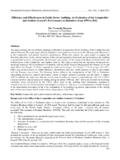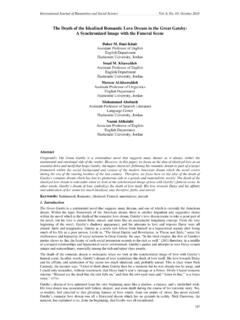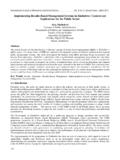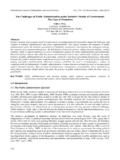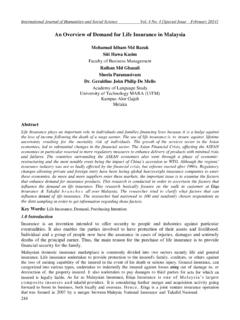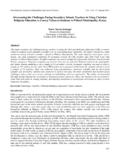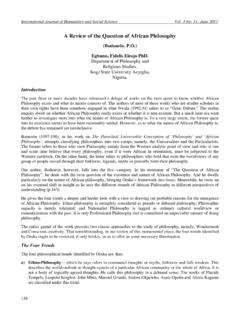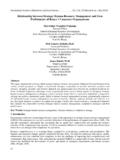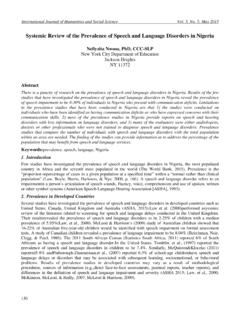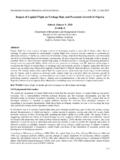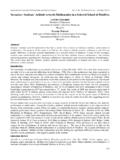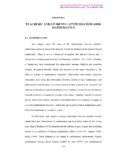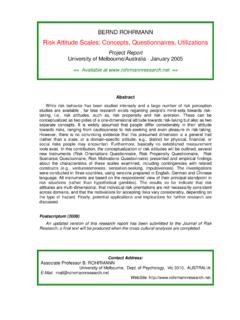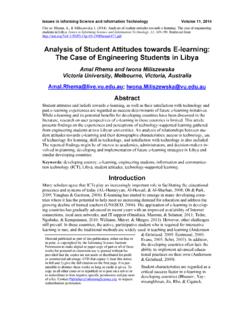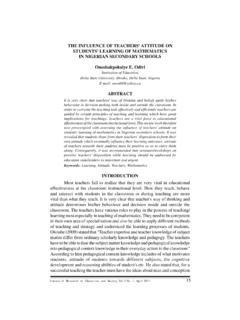Transcription of FACTORS INFLUENCING CONSUMERS’ ATTITUDE TOWARDS …
1 International Journal of Humanities and Social Science Vol. 2 No. 4 [Special Issue February 2012]. FACTORS INFLUENCING CONSUMERS' ATTITUDE TOWARDS E-COMMERCE. PURCHASES THROUGH ONLINE SHOPPING. Zuroni Md Jusoh Goh Hai Ling Centre of Excellent for Sustainable Consumption Research Department of Resource Management and consumer Studies Faculty of Human Ecology Universiti Putra Malaysia 43400 Serdang, Selangor Malaysia. Abstract Online shopping is the process of buying goods and services from merchants who sell on the internet. Shoppers can visit web stores from the comfort of their homes and shop as they sit in front of the computer.
2 The main purpose of this study is to determine the FACTORS INFLUENCING consumers' ATTITUDE TOWARDS e-commerce purchases through online shopping. The study also investigate how socio-demographic (age, income and occupation), pattern of online buying (types of goods, e-commerce experience and hours use on internet) and purchase perception (product perception, customers' service and consumers' risk) affect consumers' ATTITUDE TOWARDS online shopping. Convenience sampling method was conducted in this study and the sample comparison of 100. respondents in Taman Tawas Permai, Ipoh. Data were collected via self-administered questionnaire which contains 15 questions in Part A (respondents' background and their pattern of using internet and online buying), 34 questions in Part B ( ATTITUDE TOWARDS online purchase) and 36 questions in Part C (purchase perception TOWARDS online shopping).
3 One-way ANOVA were used to assess the differences between independent variable such as age, income, occupation and pattern of online buying (type of goods) and dependant variable such as ATTITUDE TOWARDS online shopping. The findings revealed that there is no significant difference in ATTITUDE TOWARDS online shopping among age group (F = , p < ) but there is a significant difference in ATTITUDE TOWARDS online shopping among income group (F = , p > ). The research finding also showed that there is no significant difference in ATTITUDE TOWARDS online shopping among occupation group (F = , p < ) and types of goods group (F = , p < ).
4 Pearson's correlation were used to assess the relationship between independent variable such as e-commerce experience, hours spent on internet, product perception, customers'. service and consumers' risk and dependant variable such as ATTITUDE TOWARDS online shopping. The findings revealed that there is a significant relationship between e-commerce experience and ATTITUDE TOWARDS online shopping among the respondents (r = **, p < ). However, there is no significant relationship between hours spent on internet and ATTITUDE TOWARDS online shopping among the respondents (r = , p > ). This study also indicated that there is a significant relationship between product perception and ATTITUDE TOWARDS online shopping among the respondents (r = **, p < ) and there is also a significant relationship between customers' service and ATTITUDE TOWARDS online shopping among the respondents (r = **, p < ).
5 Lastly, this result showed that there is no significant relationship between consumers' risk and ATTITUDE TOWARDS online shopping among the respondents (r = , p > ). Further study should explore other FACTORS that INFLUENCING consumers' ATTITUDE TOWARDS e-commerce purchases through online shopping with a broader range of population and high representative sampling method. INTRODUCTION. Definition of online shopping Online shopping is defined as the process a customer takes to purchase a service or product over the internet. In other words, a consumer may at his or her leisure buy from the comfort of their own home products from an online store.
6 This concept was first demonstrated before the World Wide Web (WWW) was in use with real time transaction processed from a domestic television. The technology used was called Videotext and was first demonstrated in 1979 by M. Aldrick who designed and installed systems in the United Kingdom. 223. The Special Issue on Contemporary Issues in Social Science Centre for Promoting Ideas, USA. By 1990 T. Berners-Lee created the first WWW server and browser and by 1995 Amazon expanded its online shopping experiences (Parker-Hall, 2009). The benefits of online shopping From the buyer s perspective also e-commerce offers a lot of tangible advantages.
7 For example, reduction in buyer s sorting out time, better buyer decisions, less time is spent in resolving invoice and order discrepancies and finally increased opportunities for buying alternative products. Moreover, consumers can enjoy online shopping for 24 hour per day. This is because e-commerce is open for 365 days and never close even for a minute. E- commerce also expanded geographic reach because consumers can purchase any goods and services anytime at everywhere. Hence, online shopping is more environmental friendly compare to purchase in store because consumers can just fulfill his desires just with a click of mouse without going out from house by taking any transportation.
8 OBJECTIVE. General Objective Generally, this paper is to identify the ATTITUDE of online shoppers TOWARDS online shopping. Specific Objective 1. To investigate how socio-demographic (age, income and occupation) affect consumers ATTITUDE TOWARDS online shopping. 2. To probe how the pattern of online buying (types of goods, e-commerce experience and hours use on internet). influence consumers ATTITUDE TOWARDS online shopping. 3. To examine how purchase perception (product perception, customer service and consumer risk) influence consumers ATTITUDE TOWARDS online shopping. HYPOTHESIS. Ho1: There is no significant difference between age and ATTITUDE TOWARDS online shopping.
9 Ho2: There is no significant difference between income and ATTITUDE TOWARDS online shopping. Ho3: There is no significant difference between occupation and ATTITUDE TOWARDS online shopping. Ho4: There is no significant difference between pattern of online buying (types of goods) and ATTITUDE TOWARDS online shopping. Ho5: There is no significant relationship between e-commerce experience and ATTITUDE TOWARDS online shopping. Ho6: There is no significant relationship between hours spent on internet and ATTITUDE TOWARDS online shopping. Ho7: There is no significant relationship between product perception and ATTITUDE TOWARDS online shopping.
10 Ho8: There is no significant relationship between customer service and ATTITUDE TOWARDS online shopping. Ho9: There is no significant relationship between consumers risk and ATTITUDE TOWARDS online shopping. LITERATURE REVIEW. 1 ATTITUDE Several researchers have carried out studies in their effort to examine the FACTORS INFLUENCING consumers ATTITUDE and perception to make e-commerce purchases through online shopping. attitudes toward online shopping are defined as a consumer s positive or negative feelings related to accomplishing the purchasing behavior on the internet (Chiu et al., 2005; Schlosser, 2003).
